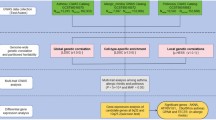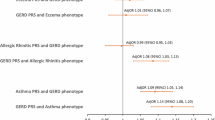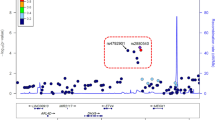Abstract
The gene for mast cell chymase (CMA1) is an ideal candidate for investigating genetic predisposition to atopic asthma, as it is an important mediator of inflammation and remodeling in the asthmatic lung. Various studies have examined the association between −1903 G/A polymorphism and allergic phenotypes, but inconsistent results have been obtained. We investigated the association of this SNP and a novel (TG)n(GA)m repeat polymorphism (accession no. BV210164) 254 bp downstream of the gene with asthma and its associated traits in a case-control study in two independent cohorts recruited from the Indian population. A significant association was observed for the (TG)n(GA)m repeat with asthma (p<0.05) in both the cohorts. Although no association was observed for the −1903 G/A SNP with asthma, a significant association was observed between the genotypes and serum IgE levels (p=0.003 and 0.0004 for cohort A and B). When haplotypes were compared between patients and controls, the haplotype G_43 was found at higher frequency in controls (p=0.05). Also, on comparing major haplotypes (>5%) with respect to log total serum IgE levels, a significant difference was obtained (p=0.018 and p=0.046 for cohorts A and B). These results suggest that the CMA1 gene contributes to asthma susceptibility and may be involved in regulating IgE levels in atopic asthma.
Similar content being viewed by others
Log in or create a free account to read this content
Gain free access to this article, as well as selected content from this journal and more on nature.com
or
References
Caughey GH, Schaumberg TH, Zerweck EH, Butterfield JH, Hanson RD, Silverman GA, Ley TJ (1993) The human mast cell chymase gene (CMA1): mapping to the cathepsin G/granzyme gene cluster and lineage-restricted expression. Genomics 15:614–620
CSGA (1997) [No authors listed] A genome-wide search for asthma susceptibility loci in ethnically diversepopulations. The Collaborative Study on the Genetics of Asthma. Nat Genet 15(4):389–392
Duvernelle C, Freund V, Frossard N (2003) Transforming growth factor-beta and its role in asthma. Pulm Pharmacol Ther 16:181–196
Forrest S, Dunn K, Elliott K, Fitzpatrick E, Fullerton J, McCarthy M, Brown J, Hill D, Williamson R (1999) Identifying genes predisposing to atopic eczema. J Allergy Clin Immunol 104:1066–1070
Geha RS, Jabara HH, Brodeur SR (2003) The regulation of immunoglobulin E class-switch recombination. Nat Rev Immunol 3:721–732
Ghosh B, Sharma S, Nagarkatti R (2003) Genetics of asthma: current research paving the way for development of personalized drugs. Indian J Med Res 117:185–197
Hart PH (2001) Regulation of the inflammatory response in asthma by mast cell products. Immunol Cell Biol 79:149–153
He S, Walls AF (1998a) Human mast cell chymase induces the accumulation of neutrophils, eosinophils and other inflammatory cells in vivo. Br J Pharmacol 125:1491–1500
He S, Walls AF (1998b) The induction of a prolonged increase in microvascular permeability by human mast cell chymase. Eur J Pharmacol 352:91–98
He SH, Xie H, Zhang XJ, Wang XJ (2004) Inhibition of histamine release from human mast cells by natural chymase inhibitors. Acta Pharmacol Sin 25:822–826
Imada T, Komorita N, Kobayashi F, Naito K, Yoshikawa T, Miyazaki M, Nakamura N, Kondo T (2002) Therapeutic potential of a specific chymase inhibitor in atopic dermatitis. Jpn J Pharmacol 90:214–217
Iwanaga T, McEuen A, Walls AF, Clough JB, Keith TP, Rorke S, Barton SJ, Holgate ST, Holloway JW (2004) Polymorphism of the mast cell chymase gene (CMA1) promoter region: lack of association with asthma but association with serum total immunoglobulin E levels in adult atopic dermatitis. Clin Exp Allergy 34:1037–1042
Kawashima T, Noguchi E, Arinami T, Kobayashi K, Otsuka F, Hamaguchi H (1998) No evidence for an association between a variant of the mast cell chymase gene and atopic dermatitis based on case-control and haplotype-relative-risk analyses. Hum Hered 48:271–274
Lazaar AL, Plotnick MI, Kucich U, Crichton I, Lotfi S, Das SK, Kane S, Rosenbloom J, Panettieri RA Jr, Schechter NM, Pure E (2002) Mast cell chymase modifies cell-matrix interactions and inhibits mitogen-induced proliferation of human airway smooth muscle cells. J Immunol 169:1014–1020
Leskinen M, Wang Y, Leszczynski D, Lindstedt KA, Kovanen PT (2001) Mast cell chymase induces apoptosis of vascular smooth muscle cells. Arterioscler Thromb Vasc Biol 21:516–522
Longley BJ, Tyrrell L, Ma Y, Williams DA, Halaban R, Langley K, Lu HS, Schechter NM (1997) Chymase cleavage of stem cell factor yields a bioactive, soluble product. Proc Natl Acad Sci USA 94:9017–9021
Mao XQ, Shirakawa T, Yoshikawa T, Yoshikawa K, Kawai M, Sasaki S, Enomoto T, Hashimoto T, Furuyama J, Hopkin JM, Morimoto K (1996) Association between genetic variants of mast-cell chymase and eczema. Lancet 348:581–583
Mao XQ, Shirakawa T, Enomoto T, Shimazu S, Dake Y, Kitano H, Hagihara A, Hopkin JM (1998) Association between variants of mast cell chymase gene and serum IgE levels in eczema. Hum Hered 48:38–41
Marshall JS (2004) Mast-cell responses to pathogens. Nat Rev Immunol 4:787–799
Mizutani H, Schechter N, Lazarus G, Black RA, Kupper TS (1991) Rapid and specific conversion of precursor interleukin 1 beta (IL-1 beta) to an active IL-1 species by human mast cell chymase. J Exp Med 174:821–825
Nagpal K, Sharma S, B-Rao C, Nahid S, Niphadkar PV, Sharma SK, Ghosh B (2005) TGFβ 1 haplotypes and asthma in Indian population. J Allergy Clin Immunol 115:527–533
Pascale E, Tarani L, Meglio P, Businco L, Battiloro E, Cimino-Reale G, Verna R, D’Ambrosio E (2001) Absence of association between a variant of the mast cell chymase gene and atopic dermatitis in an Italian population. Hum Hered 51:177–179
Sharma S, Ghosh B (2004) Association of an intragenic microsatellite marker in CC16 gene with asthma in Indian population. J Hum Genet 49:677–683
Sharma S, Nagarkatti R, B-Rao C, Niphadkar PV, Vijayan V, Sharma SK, Ghosh B (2004) A_16_C haplotype in the FcepsilonRIbeta gene confers a higher risk for atopic asthma in the Indian population. Clin Genet 66:417–425
Smith KR (2000) Inaugural article: national burden of disease in India from indoor air pollution. Proc Natl Acad Sci USA 97:13286–13293
Stephens M, Donnelly P (2003) A comparison of bayesian methods for haplotype reconstruction from population genotype data. Am J Hum Genet 73:1162–1169
Tanaka K, Sugiura H, Uehara M, Sato H, Hashimoto-Tamaoki T, Furuyama J (1999) Association between mast cell chymase genotype and atopic eczema: comparison between patients with atopic eczema alone and those with atopic eczema and atopic respiratory disease. Clin Exp Allergy 29:800–803
Tomimori Y, Tsuruoka N, Fukami H, Saito K, Horikawa C, Saito M, Muto T, Sugiura N, Yamashiro K, Sumida M, Kakutani S, Fukuda Y (2002) Role of mast cell chymase in allergen-induced biphasic skin reaction. Biochem Pharmacol 64:1187–1193
Tunon de Lara JM, Okayama Y, McEuen AR, Heusser CH, Church MK, Walls AF (1994) Release and inactivation of interleukin-4 by mast cells. Ann NY Acad Sci 725:50–58
Wang Y, Shiota N, Leskinen MJ, Lindstedt KA, Kovanen PT (2001) Mast cell chymase inhibits smooth muscle cell growth and collagen expression in vitro: transforming growth factor-beta1-dependent and -independent effects. Arterioscler Thromb Vasc Biol 21:1928–1933
Wang L, Soria JC, Chang YS, Lee HY, Wei Q, Mao L (2003) Association of a functional tandem repeats in the downstream of human telomerase gene and lung cancer. Oncogene 22:7123–7129
Yoshikawa T, Imada T, Nakakubo H, Nakamura N, Naito K (2001) Rat mast cell protease-I enhances immunoglobulin E production by mouse B cells stimulated with interleukin-4. Immunology 104:333–340
Acknowledgements
We thank our collaborating physicians Drs. S.K. Sharma, Brajen Lahker, Aditi Sinha, Virender Kumar, N.K. Bhatia and P.V. Niphadkar for helping us in sample collection. We also thank all patients, their family members, and healthy volunteers for participating in this study. We thank Ms. Mamta Sharma, Ms. Jyotsna Batra, Mr. Rajshekhar Chatterjee, Ms. Deepti Mann, Ms. Sanober Nahid, and Ms. Sangeeta Goswami for assistance. We acknowledge the Functional Genomics Unit of IGIB, Delhi, for helping in sequencing and genotyping. The financial support from the Council of Scientific and Industrial Research (CSIR), Government of India, is greatly acknowledged.
Author information
Authors and Affiliations
Corresponding author
Rights and permissions
About this article
Cite this article
Sharma, S., Rajan, U.M., Kumar, A. et al. A novel (TG)n(GA)m repeat polymorphism 254 bp downstream of the mast cell chymase (CMA1) gene is associated with atopic asthma and total serum IgE levels. J Hum Genet 50, 276–282 (2005). https://doi.org/10.1007/s10038-005-0252-x
Received:
Accepted:
Published:
Issue date:
DOI: https://doi.org/10.1007/s10038-005-0252-x



